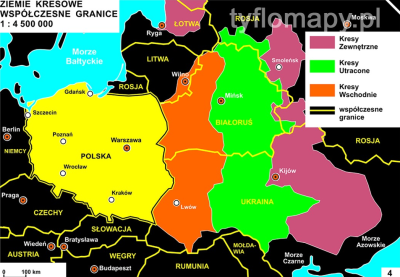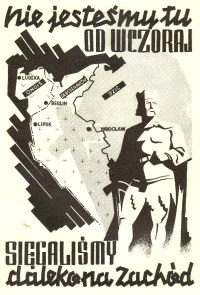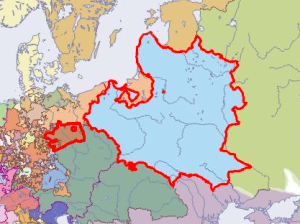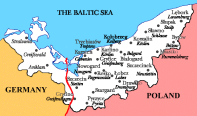imported>Borkerface2007 No edit summary |
imported>Kultokrat No edit summary |
||
| Line 56: | Line 56: | ||
[[File:Zaolzie.png|250px|thumb|left|"For 600 years we have been waiting for you (1335–1938)." Ethnic Polish band welcoming the annexation of Zaolzie by the Polish Republic]] | [[File:Zaolzie.png|250px|thumb|left|"For 600 years we have been waiting for you (1335–1938)." Ethnic Polish band welcoming the annexation of Zaolzie by the Polish Republic]] | ||
The Cieszyn Reunification concept advocates for the potential annexation of the Czech side of Cieszyn, including the broader Zaolzie region, into Poland. Originally grounded in ethnic considerations during the interwar period, given the city's majority Polish population, the current proposition maintains an ethnic foundation although demographic changes over time have led to a reduction in the percentage of Poles residing there. Alongside the ethnic basis, a historical claim has emerged due to Poland's prior ownership of the area from 1938 to 1939. Notably, the city's enduring Polish majority throughout its history, until recent times, underscores the role of Polish development and contributions to its growth, thus forming a basis for Poland's potential claim to the region. | The Cieszyn Reunification concept advocates for the potential annexation of the Czech side of Cieszyn, including the broader Zaolzie region, into Poland. Originally grounded in ethnic considerations during the interwar period, given the city's majority Polish population, the current proposition maintains an ethnic foundation although demographic changes over time have led to a reduction in the percentage of Poles residing there. Alongside the ethnic basis, a historical claim has emerged due to Poland's prior ownership of the area from 1938 to 1939. Notably, the city's enduring Polish majority throughout its history, until recent times, underscores the role of Polish development and contributions to its growth, thus forming a basis for Poland's potential claim to the region. | ||
==Western Pomerania Reunification== | ==[[File:WestpomReu.png]] Western Pomerania Reunification [[File:PolIrd.png]]== | ||
[[File:Pomerania map.png|197px|thumb|left|Map of Pomerania as a whole]] | [[File:Pomerania map.png|197px|thumb|left|Map of Pomerania as a whole]] | ||
The Western Pomerania Reunification notion rests upon two primary arguments: a legal basis and a historical foundation. Legally, proponents contend that Poland assumed jurisdiction over Pomerania upon its annexation in 1945, thus asserting its rightful authority over the westernmost portion around Greifswald, presently situated within the state of Mecklenburg. Advocates assert that for Pomerania to be reunified, this region should be integrated into the West Pomeranian Voivodeship, which administers Szczecin and holds the legitimate Pomeranian succession. As the West Pomeranian Voivodeship is within Poland, the area of Greifswald should accordingly be incorporated into Poland. Historically, the argument parallels that applied to the wider concept of the Recovered Territories, emphasizing the historical affiliation of the Duchy of Pomerania with the Kashubian-Polish Gryf dynasty's rule. This historical continuity, persisting until its partition by Sweden and Prussia, underscores Poland's legitimate claim over Pomerania, including its modern German territories. The historic Kashubian ethnic majority in Pomerania until the Ostsiedlung is mentioned, though its application as an argument is limited due to the temporal distance of this event, dating back to 1181, and the subsequent cultural shifts. | The Western Pomerania Reunification notion rests upon two primary arguments: a legal basis and a historical foundation. Legally, proponents contend that Poland assumed jurisdiction over Pomerania upon its annexation in 1945, thus asserting its rightful authority over the westernmost portion around Greifswald, presently situated within the state of Mecklenburg. Advocates assert that for Pomerania to be reunified, this region should be integrated into the West Pomeranian Voivodeship, which administers Szczecin and holds the legitimate Pomeranian succession. As the West Pomeranian Voivodeship is within Poland, the area of Greifswald should accordingly be incorporated into Poland. Historically, the argument parallels that applied to the wider concept of the Recovered Territories, emphasizing the historical affiliation of the Duchy of Pomerania with the Kashubian-Polish Gryf dynasty's rule. This historical continuity, persisting until its partition by Sweden and Prussia, underscores Poland's legitimate claim over Pomerania, including its modern German territories. The historic Kashubian ethnic majority in Pomerania until the Ostsiedlung is mentioned, though its application as an argument is limited due to the temporal distance of this event, dating back to 1181, and the subsequent cultural shifts. | ||
Revision as of 03:11, 8 August 2023
Polish irredentism encompasses the belief that certain territories not currently under Polish jurisdiction have historical, ethnic, or legal ties to Poland and should be reclaimed. This sentiment presents a range of claims and ideal borders, with variations dependent on individual perspectives. These claims can be broadly categorized into several prevailing concepts. The "Kresy Idea" centers on eastern territories, invoking the term "kresy" in Polish which translates to "borderlands." The "Recovered Territory Idea" pertains to regions such as Pomerania, Lubusz, and Silesia, with a focus on maintaining control of these areas in opposition to German irredentism. The "Saxony Claim" draws connections to the Polish-Lithuanian Commonwealth and its historical links. The "Cieszyn Reunification" emphasizes the Czech side of the Cieszyn area. The "Western Pomeranian Reunification" advocates for areas like Griefswald that were once part of the Pomerania province. The "Polabian Idea" underscores the Polish-Polabian historical connection. The "Curonian Legacy" invokes Polish claims on territories such as Latvia, Tobago, and Gambia, reflecting the Polish-Lithuanian Commonwealth's historical presence. Lastly, the "Madagascar Claim" addresses Polish historical interests in Madagascar.
 Kresy Idea
Kresy Idea 

The concept of the Kresy idea, sometimes referred to as the Kresy myth or the Eastern Borderlands, exhibits variations across different voivodeships and regions within the Kresy, with each iteration stemming from its historical origins dating back to the Polish-Lithuanian Commonwealth. In contemporary times, modern Irredentists predominantly associate the Kresy with the eastern Polish territories owned during the interwar period, often denoted as "Kresy Wschodnie" or the eastern borderlands. Claims over the Belarussian segment of the Kresy are often predicated on ethnic factors, particularly as many of the territories with Belarusian ownership have a majority Polish population. Similar considerations apply to the Lithuanian Kresy. Concerning the Ukrainian Kresy, arguments for Polish ownership pivot more on questioning the organic nature of the Ukrainian identity itself, positing it as a constructed identity by the Hapsburg Empire in the 1880s as part of geopolitical maneuvering. Additional justifications for Polish ownership encompass historical precedents, such as Lwów and its environs having been under Polish control for over 400 years, surpassing any other historical ownership. Another angle pertains to the post-1945 border adjustments, contending that the changes were illegitimate, although they were sanctioned by the Soviet Union, USA, UK, and the Polish puppet government; the Government in exile purportedly acceded to these changes under duress due to their diminished influence.
Other, more radical manifestations of the Kresy idea irredentism indeed exist, notably encompassing concepts such as "kresy utracone," which translates to "Lost Borderlands," alluding to the eastern frontiers of the Polish-Lithuanian Commonwealth post the Treaty of Andrusovo, and "kresy zewnętrzne," or "Exterior Borderlands," signifying the eastern borders after the Truce of Deulino. The arguments advocating for the ownership of these territories are less prevalent, often entwined with imperialistic aspirations for the civilization of the East and similar national schizophrenias. The thesis of the inorganic nature of Ukraine's identity can also be extended to the southern territories of kresy zewnętrzne and kresy utracone.
 Recovered territory Idea
Recovered territory Idea 

The Recovered Territories, alternatively known as the Western Borderlands or Regained Lands, pertain to the former eastern territories of Germany and the Free City of Danzig that were assimilated into Poland following World War II. This successful implementation of irredentism took place in 1945, resulting in Poland acquiring substantial territories from Germany, even those without a predominant Polish ethnic majority. The displacement of the German populace occurred, leading to the polonization of these territories. Prior to the border alteration, the foundation for Polish ownership of these lands rested upon two main aspects. Firstly, a historical rationale was presented, highlighting that these lands were historically governed by the Duchy of Poland and later the Kingdom of Poland under various dynasties. This control persisted even after the Holy Roman Empire took possession of these territories subsequent to the Piast collapse. Notably, Silesia was ruled by Polish dynasties until being eventually taken by the Habsburgs and Pomerania was ruled by the Polish-Kashubian Gryf dynasty until it was partitioned by Prussia and Sweden. Secondly, an ethnic argument emerged, applicable to Upper Silesia, Warmia, and Masuria, where a majority of the population was ethnically Polish within Germany. Today, while the historical basis endures, the ethnic argument has been extended to encompass the entirety of the Recovered Territories. Moreover, Poland's substantial development of these regions since 1945 further justifies its claim to ownership.
 Saxony claim
Saxony claim 

The Saxony Claim posits that Poland possesses a valid legal entitlement to the region of Saxony based on the historical premise that Augustus II the Strong and Augustus III jointly ruled over both the Polish-Lithuanian Commonwealth and the Electorate of Saxony. This shared governance underscores the historical interconnectedness of Poland and Saxony. Additionally, the claim draws attention to the subsequent events involving Polish succession after Augustus III, notably with Stanisław II August, which resulted in the partitioning of the Commonwealth. This partition, driven by Stanisław II August's close connections with Russia, is considered by proponents of the Saxony Claim as an unjust and illegitimate outcome. Advocates contend that had the succession followed a different path, specifically with Frederick Christian's rule succeeding Augustus III, the Polish-Lithuanian Commonwealth and Saxony could have potentially remained united and averted the partitions. It's important to note that the Saxony Claim is a topic mostly explored in alternate history contexts and is generally not regarded as a serious geopolitical contention and is often referenced as a point of discussion or debate rather than a concrete diplomatic argument.
 Cieszyn Reunification
Cieszyn Reunification 

The Cieszyn Reunification concept advocates for the potential annexation of the Czech side of Cieszyn, including the broader Zaolzie region, into Poland. Originally grounded in ethnic considerations during the interwar period, given the city's majority Polish population, the current proposition maintains an ethnic foundation although demographic changes over time have led to a reduction in the percentage of Poles residing there. Alongside the ethnic basis, a historical claim has emerged due to Poland's prior ownership of the area from 1938 to 1939. Notably, the city's enduring Polish majority throughout its history, until recent times, underscores the role of Polish development and contributions to its growth, thus forming a basis for Poland's potential claim to the region.
 Western Pomerania Reunification
Western Pomerania Reunification 

The Western Pomerania Reunification notion rests upon two primary arguments: a legal basis and a historical foundation. Legally, proponents contend that Poland assumed jurisdiction over Pomerania upon its annexation in 1945, thus asserting its rightful authority over the westernmost portion around Greifswald, presently situated within the state of Mecklenburg. Advocates assert that for Pomerania to be reunified, this region should be integrated into the West Pomeranian Voivodeship, which administers Szczecin and holds the legitimate Pomeranian succession. As the West Pomeranian Voivodeship is within Poland, the area of Greifswald should accordingly be incorporated into Poland. Historically, the argument parallels that applied to the wider concept of the Recovered Territories, emphasizing the historical affiliation of the Duchy of Pomerania with the Kashubian-Polish Gryf dynasty's rule. This historical continuity, persisting until its partition by Sweden and Prussia, underscores Poland's legitimate claim over Pomerania, including its modern German territories. The historic Kashubian ethnic majority in Pomerania until the Ostsiedlung is mentioned, though its application as an argument is limited due to the temporal distance of this event, dating back to 1181, and the subsequent cultural shifts.